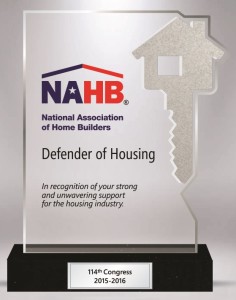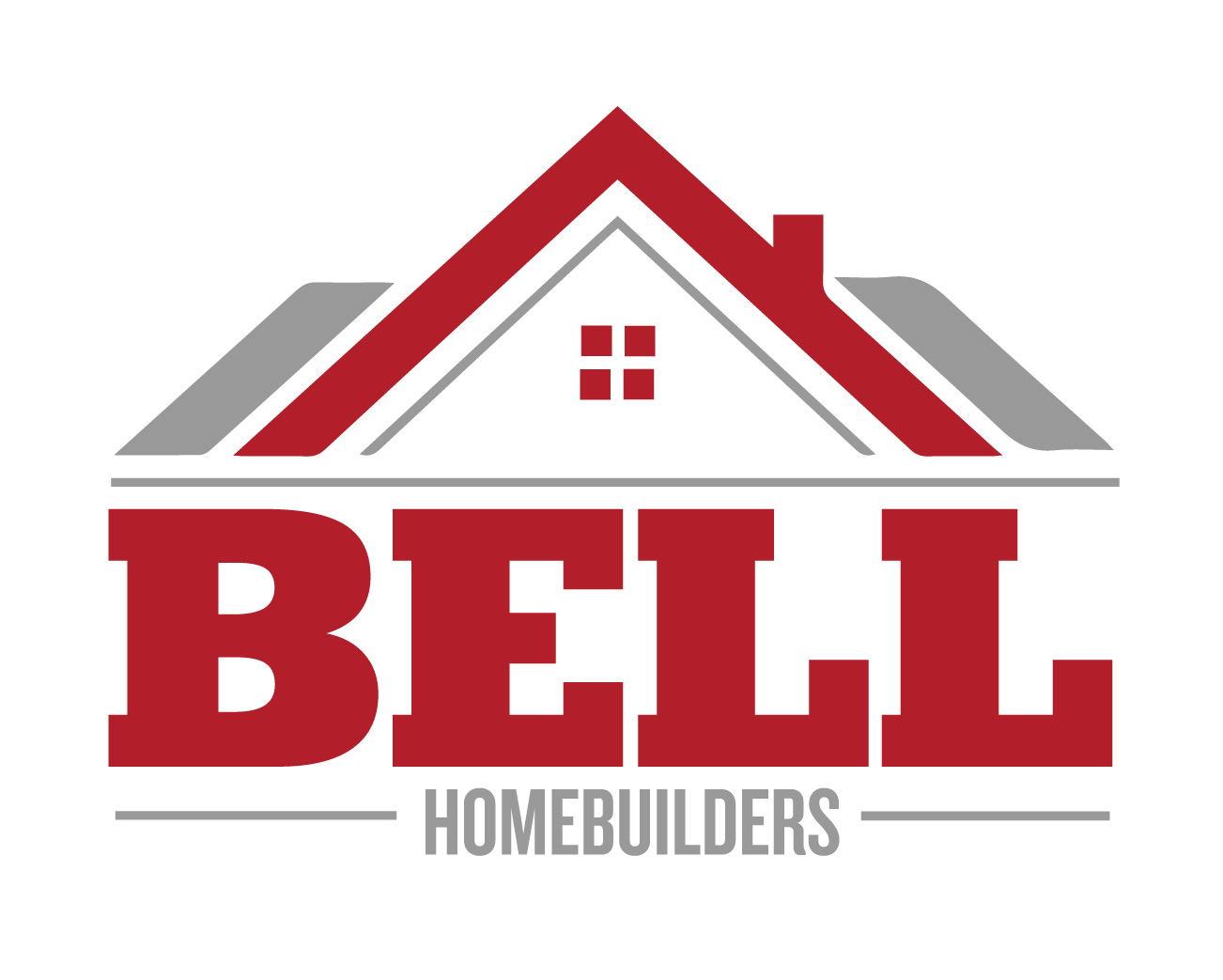
State & National Updates Archives for 2016-02
Nominate Your Legislator as a ‘Defender of Housing’

NAHB has launched the Defender of Housing award to honor our senators, representatives and state elected leadership who understand the importance of the housing industry and take stands to help it grow.
HBAs are encouraged to think about the contributions of their legislators who have demonstrated support for home building, remodeling, development and the contributions we make to the economy and submit an application.
Nominated by state and local HBA leaders, each candidate is reviewed by a select group of NAHB Federal Government Affairs Committee members before being chosen for this national award. And each legislator honored helps raise the profile of the state or local HBA making the submission.
Nominations are now being accepted and close April 29. Award winners will be announced in late May. For additional information, contact Alyssa Rajabi.
NAHB Senior Officers Discuss Key Housing Issues with Congressional Leaders
NAHB Chairman Ed Brady and First Vice Chairman Granger MacDonald this week conducted two days of meetings with Democratic and Republican leaders in both chambers of Congress to urge lawmakers to pursue a strong national agenda for housing. The NAHB Senior Officers reiterated the importance of housing and homeownership to the economy and stressed that a vibrant housing market is necessary in order to maintain robust job and economic growth.

From left, NAHB Chairman Ed Brady, House Majority Leader Kevin McCarthy
and NAHB First VIce Chairman Granger MacDonald
On Capitol Hill, Brady and MacDonald met with several influential lawmakers from both sides of the political aisle, including Senate Majority Leader Mitch McConnell (R-Ky.); Senate Minority Whip Dick Durbin (D-Ill.); House Majority Leader Kevin McCarthy (R-Calif.); House Minority Whip Steny Hoyer (D-Md.); House Appropriations Committee Chairman Hal Rogers (R-Ky.); House Financial Services Committee Chairman Jeb Hensarling (R-Texas); and Rep. Ben Ray Lujan (D-N.M.), chairman of the Democratic Congressional Campaign Committee.
Discussions focused on the need to enact policies that would provide a stable and affordable supply of credit for home buyers, home builders and rental housing and to reduce or eliminate unnecessary regulations to make homeownership more affordable for firefighters, teachers, police officers and other middle-class families. Lawmakers were also urged to address soaring health care costs by allowing the use of health reimbursement arrangements and to adopt sensible workforce development and immigration policy that will help our industry fill open jobs and boost our nation’s economy.
Amidst this presidential election year, when so much hangs in the balance for the housing industry, these meetings will help to lay the groundwork for a successful Bringing Housing Home™ NAHB Legislative Conference during the week of March 7-11 when our members will hold in-district meetings with their lawmakers.
Builders are encouraged to log on to BringingHousingHome.com now and register to attend the industry’s most important lobbying event of the year.
For more information on Bringing Housing Home, email Michael Persaud at NAHB or call him at 800-368-5242 x8542.
Builders Cite Their Top Challenges in 2016
Topping the list of problems builders faced in 2015 and expect to face in 2016 is the cost/availability of labor, according to a recent survey that NAHB conducted of our members.
As NAHB economist Ashok Chaluvadi reported in a recent Eye on Housing blog post, 76% or builders expect this to be a major issue in 2016. Labor concerns have increased in importance during the past three years. In 2013, 53% of builders rated labor as a significant problem, followed by 61% in 2014 and 71% in 2015. An expected skilled labor shortage can constrain an improving housing market.

To read more, click HERE.
Obama’s $4.1 Trillion Budget Proposal is DOA on Capitol Hill
 President Obama on Feb. 9 unveiled a $4.1 trillion fiscal year 2017 budget proposal to Congress that is up 5% from the current year.
President Obama on Feb. 9 unveiled a $4.1 trillion fiscal year 2017 budget proposal to Congress that is up 5% from the current year.
But Republicans have made it clear they won’t even consider the proposal. GOP lawmakers made the unusual move of not even inviting Office of Management and Budget Director Shaun Donovan to testify about the 2017 budget – further evidence of the ongoing gridlock and partisan divide that now grips Washington.
Still, the White House budget serves as the initial marker in the budget battle ahead. Given the size, cost, complexities and major policy overhauls that this blueprint entails, the debate in the weeks and months ahead is likely to be contentious as lawmakers on both sides of the political aisle consider its merits on an array of fronts- from social spending, energy policy to taxes.
Here’s how the proposed budget relates to the residential construction industry.
HUD
-
Proposes $48.9 billion in HUD funding, a 15% increase over the $42.6 billion provided in the fiscal 2016 omnibus spending bill the President signed on December 18, 2015.
-
Provides $20.85 billion for Section 8 Tenant Based Rental Assistance, with $18.45 billion for contract renewals and $7 million for Veterans Affairs Supportive Housing (VASH). The fiscal 2016 approved appropriation provided $19.6 billion for the Section 8 program, with $17.68 billion earmarked for renewals and $60 million for VASH.
-
Proposes $10.82 billion for Section 8 Project-based Rental Assistance, with $10.03 billion for contract renewals. Last year’s budget provided $10.62 billion for the program.
-
Funds the HOME Program at $950 million, the same level as last year.
-
Decreases Community Development Block Grant funding from $3 billion to $2.8 billion.
-
Increases Choice Neighborhoods funding from $125 million to $200 million.
USDA
-
Funds the Section 502 Direct Loan Program at $900 million, the same level as last year.
-
Maintains funding for the Section 502 Guaranteed Rural Housing Loan Program at $24 billion, the same level as last year.
-
Increases funding for the Section 515 Multifamily Direct Loan Program from $28.4 million to $33 million.
-
Boosts funding for the Section 538 Multifamily Guaranteed Program from $150 million to $230 million.
-
Provides $1.41 billion in funding for the Section 521 Rental Assistance Program. Last year’s budget provided $1.39 billion, with $75 million to renew contracts that were insufficiently funded in fiscal 2015.
-
Allocates $34 million for multifamily housing revitalization, with $18 million for vouchers. Last year’s budget provided $37 million, with $15 million for vouchers.
As the budget process moves forward in the year ahead, NAHB will remain deeply engaged, fighting to strip out any provisions that will harm housing and promoting elements that will help small businesses and the housing sector.
For more information, email Jessica Hall at NAHB or call her at 800-368-5242 x8253
EPA Makes Changes to Lead-Safe Re-certification Process
Remodelers who are certified by the Environmental Protection Agency (EPA) to work on homes that may contain lead paint under the Lead: Renovation, Repair and Painting (RRP) rule now have the option to complete refresher training online, according to an EPA announcement.
However, EPA re-certifications obtained via an online refresher course will be valid for only three years – versus five years for hands-on training courses – and can only be exercised every other re-certification cycle.
“As a longtime advocate for a simplified re-certification process, NAHB Remodelers appreciates that EPA’s changes provide some flexibility, but the limited and convoluted parameters of the online training option are unnecessarily complicated and could affect the number of renovators who opt to become re-certified,” said NAHB Remodelers Chair Tim Shigley, CGR, CAPS, CGP, GMB, GMR, a remodeler from Wichita, Kan.
“Whether they choose to refresh their training online or in person, with the March 31 re-certification deadline looming for over 100,000 remodelers, and thousands more later in 2016 and 2017, remodelers are left with precious little time to meet their re-certification obligations.”
Additionally, certified renovators who were grandfathered in under a HUD or EPA lead-based paint training course before the RRP rule was adopted must attend a refresher course with a hands-on component. The rule also made several streamlining and clarifying changes to RRP provisions that apply to training providers.
EPA’s changes only apply to those states where EPA administers the program. The 14 states that administer their own programs will have to take legislative or regulatory action to adopt the online refresher course option.
The White House Office of Management and Budget released the final rule to EPA on Jan. 21.
For online or in-person refresher training, remodelers should contact their local home builders association, or they can find a course on EPA’s website. More information on how to determine specific deadlines can be found using NAHB’s “What You Need to Know about EPA Lead-Safe Re-certification.”
U.S. Supreme Court Stays EPA’s Clean Power Plan
In a highly unusual move, the U.S. Supreme Court last night halted implementation of the Clean Power Plan Rule, which requires states to reduce carbon dioxide emission from power plants located within their borders.
While the rule is supposed to focus on power plants, EPA’s emission reduction requirements are so stringent that states will have to use a variety of mechanisms to meet them.
Because EPA has encouraged states to use building energy efficiency, including the imposition of building codes, as a way to comply with these targets, NAHB has been engaged on this rule from the beginning, filing comments that significantly improved EPA’s treatment of energy efficiency in the final rule.
However, because incentives remain for states to use energy efficiency to meet these onerous requirements, NAHB, along with many other parties, filed a petition for review with the U.S. Court of Appeals for the D.C. Circuit challenging the rule.
The states and some industry groups asked the D.C. Circuit to halt implementation of the rule while it is being litigated. The court refused, and these groups then asked the U.S. Supreme Court to delay the rule.
The Supreme Court, in a 5-4 decision, granted these groups’ requests. States will now be relieved of taking action immediately to try and meet the rule’s deadlines, and can instead hold off until after the courts have decided whether the rule is legal, which likewise provides relief for impacted industries as well, including NAHB’s members.
How to Stay Profitable When Competing with Large Volume Builders
Small-volume builders who are feeling boxed in by large production builders in their area should take heart. Daniel Levitan, MIRM, IRM Fellow, CMP, CSP, owner of Levitan & Associates in Fort Lauderdale, Fla., who recently spoke at the NAHB International Builders’ Show, said there are numerous ways to push back and stay profitable.
Levitan conceded that large production builders have a lot of advantages over small-volume builders. To list a few:

– Easy access to capital
– Economies of scale
– Favorable treatment from subcontractors
– Library full of home plans with known costs
– Market visibility
– Sales and marketing efficiency
– Ability to survive market conditions
The upside for small-volume builders, however, is that most production builders are resistant to change, typically unable to respond rapidly to new opportunities or create new housing products, and find it challenging to take on smaller jobs or sites or typical developments. “And as most of you know, some of the small projects are more profitable than the large ones,” Levitan said.
Large volume builders also struggle to market outside of their established comfort zone, and are rarely able to accommodate requests for customization. So if you want to stay competitive with the big builders, Levitan recommends the following:
- Develop a significant Web presence to make yourself stand out.
- At a minimum, do some limited customization.
- Build in a sub-market. Go where the big builders won’t go.
- Directly target their weakness. For example, if they build quality, build to price or vice versa.
- Fill in the holes they leave behind. “If they’re doing all brick, you do stucco. If they’re doing one-story houses, you do two-story houses,” Levitan said.
- Partner with other small-volume builders.
- Find private investors.
-
Pursue urban infill housing opportunities.
Interested in learning more? Search NAHBNow.com or visit NAHB.org for additional tips, strategies, articles and resources.
OMB Releases Stricter ‘Critical Habitat’ Final Rules
The White House Office of Management and Budget released a final Endangered Species Act (ESA) rulemaking on Friday that could make it more difficult for developers and builders to obtain federal wetland permits.
NAHB is particularly concerned about how these rules could increase the size of future critical habitat designations. Once adopted, these ESA regulations will dramatically expand what types of habitat qualify as suitable for listed species.
Historically, federal regulators focused on areas occupied by the species and areas with specific physical or biological features to support the species.
This new rule would allow federal regulators to designate habitat that does not include the species nor any important physical or biological features, provided these areas could eventually develop such features or be used by the species.
The rules will be jointly administered by the U.S. Fish and Wildlife Service and the National Oceanic and Atmospheric Administration and become enforceable 30 days after being published in the Federal Register, which is expected within a week.
Once finalized, these regulations will make it extremely difficult for landowners and states to refute a federal determination that their properties or state lands should be designated as critical habitat.
These ESA rules, when combined with the expanded definition of ‘waters of the U.S.’ under the Clean Water Act, will significantly and unnecessarily increase the areas regulated by the federal government while providing little added environmental protection.
For additional information, contact Mike Mittelholzer.
Don’t Be Afraid of Smart Home Technology

The smart-home technology craze began years ago in some parts of the country, but in many other areas, it’s only just begun.
If you’re just entering this market, or have yet to do so because you think you don’t have the know-how, fear not – you don’t need to be a technology specialist. But you should become familiar with what’s trending and how you can address your clients’ needs before they go to another builder.
Product developers are constantly churning out new gizmos, like the thousands that were displayed at the recent Consumer Electronics Show. But only a small number are actually embraced by the general public.
Get a feel for what’s really trending
During an education session at this year’s International Builders’ Show, Greg Haupert, the executive director of Business Networking International and a home-technology integration specialist, listed several smart-home trends that have truly started to take root, including:
-
Contemporary comfort with automated thermostats, lighting and security systems that quickly learn the owner’s preferences and can be controlled and monitored from anywhere in the world.
-
High-tech appliances like refrigerators with internal cameras that allow the owner to remotely check its contents, and an automated compressor that adjusts its speed according to how much food is inside.
-
Smart TVs – not simply those that run apps like Netflix and Hulu, but rather, TVs that are integrated to create a smart-home hub through which many, if not all of the home’s smart features can be controlled.
Many other experts at IBS recommended several more design trends and innovative products builders should consider.
Team up with an expert
Once you know what’s hot among consumers, but don’t feel confident enough to market yourself as a smart-home specialist, Haupert suggests partnering with one.
It’s okay to admit you don’t have all the technology answers as long as you partner with or employ someone who does, and who can comfortably interact with the client.
“Having a smart-home technology expert that you can rely on and consult with for certain projects will help boost your business and reputation,” Haupert said. “Don’t assume that [a tech specialist’s] only goal is to up-sell the client. When you find a trustworthy partner whom you can work with consistently, that will better enable you to meet your clients’ needs.”
Furthermore, he suggests working with contractors who can offer service contracts to the client. This will reduce your liability if (or rather, when) issues arise.
Plan ahead
But before you get too far down the road with a client, it’s critical to develop a technology plan as early as possible. Custom A/V and smart-home technology is best integrated when planned for well in advance. Pre-wiring a new home can save the client thousands down the road.
Haupert strongly advises that builders find out which pieces of technology the client wants and how they want to use them in their home. From there, go through the floor plan room by room and ask how they might want to use the technology in each space.
NAHB has several educational opportunities for industry professionals who want to learn more about integrating design and technology. Go to nahb.org for additional info.






